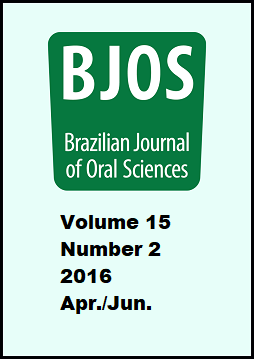Abstract
Aim: To study influence of the cooling rate after sintering a veneering porcelain (Vita VM9) on fracture toughness by indentation strength (IS) and single-edge-v-notched beam (SEVNB) methods. Methods: Vita VM9 bars were sintered according to the manufacturer’s recommendation and cooled under three conditions: Slow (inside the furnace from sintering temperature to room temperature); Normal (inside the furnace from sintering temperature to 500 ºC and outside the furnace from 500 ºC to room temperature); and Fast (outside the furnace from sintering temperature to room temperature). Fracture toughness was measured by IS (n=10) and SEVNB (n=10) methods. Data were analyzed by two-way ANOVA (α=0.05). Results: The fracture toughness obtained from SEVNB (slow - 1.02±0.10; normal - 1.09±0.13; and fast - 1,02±0.18 MPa.m1/2 cooling techniques) was significantly lower than IS (slow - 1.19±0.13; normal - 1.17±0.07; and fast - 1.16±0.06 MPa. m1/2 cooling techniques). There was no significant influence of the cooling technique (p=0.012). Conclusions: The measurement technique influenced the fracture toughness values . IS method overestimated the fracture toughness values. Irrespective of the measuring method, cooling rate did not influence the Vita VM9 veneering porcelain fracture toughness.References
Sailer I, Feher A, Filser F, Gauckler LJ, Luthy H, Hammerle CH. Five year clinical results of zirconia frameworks for posterior fixed partial dentures. Int J Prosthodont. 2007 Jul-Aug;20(4):383-8.
Choi JE, Waddell JN, Swain MV. Pressed ceramics onto zirconia. Part 2: indentation fracture and influence of cooling rate on residual stresses. Dent Mater. 2011 Nov;27(11):1111-8. doi: 10.1016/j.dental.2011.08.003.
Swain MV. Unstable cracking (chipping) of veneering porcelain on allceramic dental crowns and fixed partial dentures. Acta Biomater. 2009 Jun;5(5):1668-77. doi: 10.1016/j.actbio.2008.12.016.
Göstemeyer G, Jendras M, Dittmer MP, Bach F, Stiesch M, Kohorst P. Influence of cooling rate on zirconia/veneer interfacial adhesion. Acta Biomater. 2010 Dec;6(12):4532-8. doi: 10.1016/j.actbio.2010.06.026.
Pjetursson BE, Sailer I, Makarov NA, Zwahlen M, Thoma DS. All-ceramic or metal-ceramic tooth-supported fixed dental prostheses (FDPs)? A systematic review of the survival and complication rates. Part II: Multiple-unit FDPs. Dent Mater. 2015 Jun;31(6):624-39. doi: 10.1016/j. dental.2015.02.013.
Mackert JR, Jr., Evans AL. Effect of cooling rate on leucite volume fraction in dental porcelains. J Dent Res. 1991 Feb;70(2):137-9.
Mackert JR, Jr., Twiggs SW, Russell CM, Williams AL. Evidence of a critical leucite particle size for microcracking in dental porcelains. J Dent Res. 2001 Jun;80(6):1574-9.
Mecholsky JJ Jr. Fracture mechanics principles. Dent Mater. 1995 Mar;11(2):111-2.
Scherrer SS, Denry IL, Wiskott HW. Comparison of three fracture toughness testing techniques using a dental glass and a dental ceramic. Dent Mater. 1998 Jul;14(4):246-55.
Wang RR, Lu CL, Wang G, Zhang DS. Influence of cyclic loading on the fracture toughness and load bearing capacities of all-ceramic crowns. Int J Oral Sci. 2014 Jun;6(2):99-104. doi: 10.1038/ijos.2013.94.
Wang H, Pallav P, Isgro G, Feilzer AJ. Fracture toughness comparison of three test methods with four dental porcelains. Dent Mater. 2007 Jul;23(7):905-10.
Fischer H, Waindich A, Telle R. Influence of preparation of ceramic SEVNB specimens on fracture toughness testing results. Dent Mater. 2008 May;24(5):618-22.
Triwatana P, Srinuan P, Suputtamongkol K. Comparison of two fracture toughness testing methods using a glass-infiltrated and a zirconia dental ceramic. J Adv Prosthodont. 2013 Feb;5(1):36-43. doi: 10.4047/ jap.2013.5.1.36.
Fischer H, Marx R. Fracture toughness of dental ceramics: comparison of bending and indentation method. Dent Mater. 2002 Jan;18(1):12-9.
International Organization for Standardization. ISO 6872: 2008: Dental ceramics, Switzerland; 2008.
Hermann R, Moffatt J, Plumbridge WJ. A comparison of crack initiation techniques for ceramics. J Mater Sci Lett. 1995;14:282-4.
Quinn JB, Sundar V, Lloyd IK. Influence of microstructure and chemistry on the fracture toughness of dental ceramics. Dent Mater. 2003 Nov;19(7):603-11.
Anstis GR, Chantikul P, Lawn BR, Marshall BD. A critical evaluation of indentation techniques for measuring fracture toughness: I, Direct crack measurement. J Am Ceram Soc. 1981;64(9):533-8.
Evans AG, Charles EA. Fracture toughness determinations by indentation. J Am Ceram Soc. 1976;59:371-2.
Pecnik CM, Courty D, Muff D, Spolenak R. Fracture toughness of esthetic dental coating systems by nanoindentation and FIB sectional analysis. J Mech Behav Biomed Mater. 2015 Jul;47:1-11. doi: 10.1016/j. jmbbm.2015.03.006.
Coldea A, Swain MV, Thiel N. In-vitro strength degradation of dental ceramics and novel PICN material by sharp indentation. J Mech Behav Biomed Mater. 2013 Oct;26:34-42. doi: 10.1016/j.jmbbm.2013.05.004.
Strecker K, Ribeiro S, Hoffmann MJ. Fracture toughness measurements of LPS-SiC: A comparison of the indentation technique and the SEVNB method. Mater Res. 2005 Feb;8(2):121-4.
Chai H, Lawn BR. A universal relation for edge chipping from sharp contacts in brittle materials: A simple means of toughness evaluation. Acta Mater. 2007 Apr;55:2555-61.
Guazzato M, Albakry M, Swain MV, Ironside J. Mechanical properties of In-Ceram Alumina and In-Ceram Zirconia. Int J Prosthodont. 2002 Jul-Aug;15(4):339-46.
Almeida AA Jr, Longhini D, Domingues NB, Santos C, Adabo GL. Effects of extreme cooling methods on mechanical properties and shear bond strength of bilayered porcelain/3Y-TZP specimens. J Dent. 2013 Apr;41(4):356-62. doi: 10.1016/j.jdent.2013.01.005.
Cesar PF, Yoshimura HN, Miranda Junior WG, Okada CY. Correlation between fracture toughness and leucite content in dental porcelains. J Dent 2005 Oct;33(9):721-9.
Ong JL, Farley DW, Norling BK. Quantification of leucite concentration using X-ray diffraction. Dent Mater. 2000 Jan;16(1):20-5.
The Brazilian Journal of Oral Sciences uses the Creative Commons license (CC), thus preserving the integrity of the articles in an open access environment.

